#bikini review
Explore tagged Tumblr posts
Text





#girlblogging#sillyposting#girlhood#mecore#thoughts#whimsical#deergirl#film girl#lgbt cinema#elvira#films#give me movie recommendations please#movies#movie review#top 10 movies#2024 movies#gothic#riot grrrl#bikini kill
9 notes
·
View notes
Text
the new spongebob movie is very very not good
15 notes
·
View notes
Text
Saving Bikini Bottom is not just a disservice to my girl Sandy, but also an irritating laugh-free experience. If there's one thing to define "Bad SpongeBob", this is it.
My ★ review of Saving Bikini Bottom: The Sandy Cheeks Movie (2024) on Letterboxd:
#netflix#nickelodeon#spongebob#spongebob squarepants#sandy cheeks#saving bikini bottom: the sandy cheeks movie#saving bikini bottom#review#movie review#film review#letterboxd
4 notes
·
View notes
Text
I dont understand tumblr for marking my content "Mature" when its a study but keeps blasting Inappropriate ad...
#i just scrolled to my feed and saw literally an oversexualized ad for “bikini area whitening”#it was very softcorn coded#did i do anything wrong or the bots here are just that stupid#i feel like that community label review should be off now#someone said bots determine it by “how much skin” is shown in the drawing...i didnt know we was a religious school
21 notes
·
View notes
Text
I watched the “Saving Bikini Bottom: Sandy Cheeks” movie recently, and there’s this one part out of many that solidified the feeling that this movie was definitely a low point in the list of SpongeBob movies.
SPOILERS AHEAD
Nearby the end of the movie Sandy’s family gets called using a whistle and they easily enter in the lab that the main cast are trapped, which is weird because I thought it was established that it’s a pretty hard place to enter but idk, I wasn’t taking notes.
Anyways, the family tries to save bikini bottom all by themselves but it seems like they can’t, until they quickly come up with a plan that involves more people and then Pa Cheeks takes a steel beam and bends it as everybody watches and SpongeBob says “[sigh] he’s so masculine.” and then Pa responds “Yep, even my muscles got muscles!”. That part stood out to me for a while and I didn’t know why, until I realized that:
1. Why would they spell that out for everyone when it was already established earlier in the movie that Pa is the strongman of the circus family?
2. I’m not sure if this is a real thing, but I think some characters have a original voice to them and I think SpongeBob would never say that casually, he’d use the word ‘macho’ in that scenario. I guess the word masculine is just too precise and long for it to be in SpongeBob’s casual vocabulary?
They probably did that part just to fill the air, but they could have had it where Sandy gives out instructions to everyone, and then we see them all doing what’s needed through a quick montage to each person so then it feels like it’s a bit more build up to the escape and it’d feel much more busy instead.
BTW be aware that I might be wrong because this is based off of a fuzzy memory of the movie. Anyways, thanks for reading my first small movie criticism!!
#spongebob#spongebob movie#saving bikini bottom: the sandy cheeks movie#spongebob squarepants#I just realized the title of the movie sounds like a long butt joke lol#movie review
2 notes
·
View notes
Text

A couple of jokes that land and some enjoyable performances from Tom Kenny/Wanda Sykes make this film watchable. But bad jokes, writing, performances, visuals, and art styles show it for what it is, a disservice to the original show.
#spongebob#spongebob squarepants#sandy cheeks#saving bikini bottom: the sandy cheeks movie#saving bikini bottom#tom kenny#wanda sykes#netflix#paramount pictures#paramount animation#movie#movies#movie review#movie reviews#film#films#film review#film reviews
4 notes
·
View notes
Text
youtube
In a power dive In a slow burn Over ancient fields Over islands From the slope and the rise Of the mainland Unfamiliar shores Through the atmosphere Over rain clouds To the brimming bowl Coral-inlaid How we lit them up Everlasting With the sun in our eyes
#shearwater#music#obsessed obsessed obsessed with this live version but also like#the song itself is so fucking wild.#from--as near as i can tell--the pov of one of the pilots who dropped nukes on bikini atoll during US testing#god this whole album is so fucking beautiful and gutwrenching and i scream whenever i read a review that's liek#oh pretty island songs :)#WHICH ISLANDS SPECIFICALLY. HUH?#how we lit them up everlasting. with the sun in our eyes.#Youtube
2 notes
·
View notes
Text
The (absent) demise of the "Riot Grrrl" genre!
Disclaimer: this text was created for an essay submission, so the prose may not be similar to my other blog posts. Nonetheless, it is still incredibly important to me, along with being one of the best pieces of work I have ever had the honour of constructing. Thank you for reading.
What essentially birthed the genre of 'Riot Grrrl' music was the exclusion of women in musical spaces regarding the punk-rock persuasion and punk movement throughout the 1970s. Although the involvement of women began to become prevalent during the second wave of feminism, with bands like X-Ray Spex and The Slits being formed, punk-rock was still seen as ‘cock rock’, a loud and predominantly male genre. It seemed as if there was no room for the inclusion of female artists within the genre of punk-rock. That is, until the start of the 1990s and the third wave of feminism, where the formation of a specific band called Bikini Kill began the rise of the Riot Grrrl movement, dedicated to tackling feminist issues and providing a focus on the political, social, and economic disenfranchisement faced by women. These weren't bands consisting of heavily skilled musicians, for half of Bikini Kill's members played their instruments without any prior experience or knowledge. This wasn't entirely unspoken of, for there were many boy bands who were getting up on stage without knowing how to really play a note. The difference is, Bikini Kill believed possessing musical talent within skill wasn't important; the true talent lied in using their music as a tool for activism. This is why one of the most influential aspects of the Riot Grrrl movement was the usage of zines to spread the feminist manifesto and the rise of these upcoming bands, for zines were the perfect tool of visual art that best emphasised the 'do it yourself' persona attached to the Riot Grrrl and punk movements. By creating sources of media that highlighted issues of sexism, patriarchy, abuse, sexuality and rape, especially through the female gaze, the Riot Grrrl movement was further strengthened by the formation of bands such as Bratmobile and Heavens to Betsy along with Bikini Kill. Although incredibly influential for women's liberation and shining a light on the issues they face, Riot Grrrl is infamously known for its exclusion of intersectionality within visual representation: there were issues of racism disclosed and explored in Riot Grrrl zines, however Emmanuelle Mphuthi reiterates that 'none of the revered figures of (the) movement were Black or women of color.' Despite this, there is a huge question surrounding whether the movement has died or if there is a resurgence occurring in contemporary society for the 'Riot Grrrls' of this generation.
Replacing the "i" with three r's, allowing a growl paired with "girl", "Grrrl" is a forceful reclamation of girlhood, by reiterating it in the stance of female anger perfectly paired with the genre's howling vocals in a bid to reject female subordination and accept female animosity. Along with this, it is the re-establishment of the naughty, confident and curious personalities young girls possess before they begin their venture in society as young women, demonised and degraded by the patriarchy to stop being loud and to stop playing with boys and to concentrate on learning how to girl. Due to the genre's innate rejection of gender stereotypes, it is no surprise that it is filled with aggressive displays of women empowerment and girl power. Arriving at the end of the second wave of feminism, where the debate regarding the legalisation of pornography was existent due to anti-pornography feminists wanting to limit the porn industry as it catered only to men and encouraged violence towards women, some feminists deemed this as repressive as there were women who chose sex work, and to limit the porn industry would be to limit their work. Already, before the start of the third wave of feminism, there is debate regarding a woman's choice. With the third wave of feminism beginning with the 1991 Anita Hill testimony, a sense of liberation is tied with intersectionality for the first time, this new wave of feminism focusing on race and gender and political representation and equality for women.
This only helped prompt an emphasis on reproductive rights for women, much like the second wave, hence the brutal honesty surrounding female empowerment through punk rock to begin discussions of patriarchy and body image for the female youth. Thus, the Riot Grrrl movement is constructed and strengthened, paving a way for the female youth to be involved within the punk movement; for youth has always been a motif in the punk milieu because its attitude naturally rebels against authority. Best depicted in the genre's lyrics, there is an obvious distinction between the male perspective and the female perspective: Blink-182 writes 'I want a girl that I can train' in one of their songs; the Ramones write 'well, you're a loudmouth, baby / you better shut it up! / I'm gonna beat you up', perpetuating elements of physical violence and harmful hegemonic-masculine attitude towards female subordination. In contrast with this, Bikini Kill writes 'Just cause my world, sweet sister / Is so fucking goddamn full of rape, / Does that mean my body / Must always be a source of pain?', highlighting the normalisation of rape culture and the issues regarding the female body. In doing so, along with the use of the word "sister" to address their female audience and the brutally explicit drop of the word "rape", Bikini Kill emphasises the fact that Riot Grrrl is all about being raw and not being afraid to have those conversations. It is this unfiltered, gritty and brave attitude of Riot Grrrl bands that allows the movement to be influential and inspiring for (young) generations of women.
In accordance with themes of feminism and girl power, the usage of zines in the nineties helped convey a tinge of individuality to the Riot Grrrl movement. In its entirety, the movement was a personal and brutally honest conception, best depicted in zines' manifesto-like nature, emphasising the youthful framework attached to what these zines were highlighting with their messy hand-written font and eccentric colours, such as hot pink paired with black. One of the zines published by Bikini Kill featured a hand-written flier, acting as a feminist manifesto, with lines such as 'Resist the temptation to view those around you as objects and use them' and 'Burn down the walls that say you can't' - the latter underlined aggressively in black marker juxtaposed with a crimson red background. This further highlights Riot Grrrl's ambition to focus on the individual's responsibility not to perpetuate the system of oppression and how to tackle the personal in political terms. With the use of a crimson red paired with black, there is a sense of feminine urgency attached, depicting the nature of a woman celebrated through her menstruation.
Another reason why zines were the perfect tool for the Riot Grrrl movement is because when analysing the movement now, there is a sense of nostalgia attached: in the age of no advanced internet or technology, zines were the best tool for quickly and locally disseminating information beyond and before web content, especially in youth culture. Along with this, zines had a unique way of portraying a confrontational style of in-your-face politics, which was perfect for the third wave of feminism, portraying a sense of belonging for the individual as anyone could make a zine about anything. The entire essence of the Riot Grrrl movement was that it was an opposition of the mainstream, best conveyed with the use of zines as they helped capture a culture in a way that mainstream, conventional and often exclusionary models of publishing couldn’t.
As influential as Riot Grrrl was for advocating for women’s liberation and sexual freedom, one of the strongest criticisms of the movement was that it lacked the emphasis on women of colour entirely. Highlighting female anger, it is no coincidence that the movement gained a large fanbase after the 1991 Anita Hill testimony, for female thought was provoked and encouraged by the case’s emergence; a movement that was kick-started by the abuse of a Black woman possessed so few Black representatives at its helm. Furthermore, the punk-rock genre was deemed a predominantly white, male genre - a common misconception due to the silencing of many Black musicians. Dating back to the early 1900s, music composed and released by Black individuals was categorised as 'race music' in order to profit off communities of color whilst also restricting the music played on white radio stations.
In terms of the punk-rock genre, however, many believe it has become whitewashed; there were Black punk bands pioneering the punk movement with their fresh new ideas long before The Clash and the Sex Pistols, such as Death, a band composed of three young black brothers who have gained a large cult following today. Retrieving attention back to the Riot Grrrl movement, there is also X-Ray Spex, with the frontrunner being a young Black woman, refusing to adhere to society's objectification of her body. Yet, despite this, it is a sad fact that although X-Ray Spex paved the way for the Riot Grrrl movement long before it was constructed, Bikini Kill is the band connected to the movement the most. In addition to this, there is the inclusion of Courtney Love’s band Hole as one of the most influential bands within the Riot Grrrl Movement, with a discography full of songs that advocated for badass and unapologetic feminists. Despite this, Love has been heavily criticised by many intersectional feminists for her racist comments, where she previously demanded the crowd at one of her concerts to 'scream the n-word', along with asking a Black woman whether she really does enjoy rock music, for she is Black and that would be synonymous with Love, a white woman, 'being into Lil Wayne.' Highly detrimental to the nature of the Riot Grrrl movement, Love has also been criticised for her victim-blaming comments, where she asked a woman who had been raped why she didn’t expect it to happen. It is often a shock for many Hole fans when reminded of this altercation, for Love wrote the feminist anthem ‘Asking for It’, a song highlighting the brutal nature of rape and the long-term effects of assault on victim-survivors; many victim-survivors refuse to acknowledge Love as a feminist icon, for her comments surrounding victimhood and victim-blaming remain harmful.
Further supported by Bikini Kill’s Kathleen Hannah, Love was called out by the queen of the Riot Grrrl movement, only to be met with physical violence by the hands of Courtney Love. This best highlights the damaging notion the Riot Grrrl movement advertised that if a woman is strong and opinionated then she is, by default, the poster girl of feminism even if her so-called feminism ignores racism, transphobia, ableism, classism and so on. On the other hand, what frustrates many women of colour who are consumers of the Riot Grrrl genre is the lack of representation within the movement for themselves. Described as a movement for the 'young, white, suburban and middle class' women in society, many feminists would wholeheartedly disagree, for that is only what the media focused on. The real riot Grrrls were those of all ethnicities, especially the black women that participated in (and out of) the movement. These black women carved their own feminist pathways into the hard core scene solely because they were rendered invisible by the movement itself, such as Ramdasha Bikceem, a young Black woman who constructed a Riot Grrrl zine in the perspective of a black Riot Grrrl. It is an inspiring and influential notion tied to the nature of Riot Grrrl, yet it is also heart-breaking, for no woman of colour's contributions to the movement should be swept under a rug of whiteness and should instead, be at the forefront of the movement along with their white peers.
Embedded within the celebration of all women and unapologetic female anger, the Riot Grrrl genre would thrive in contemporary society – or would it? The movement itself is as relevant today as it was back when it was formed, especially tied with the #MeToo movement, however the entire essence of the Riot Grrrl movement is an opposition to the mainstream, and with the rise of pop music towards the end of the nineties, therein occurs the loss of interest by the media and the 'death of Riot Grrrl' in 1995 and 1996. Yet, despite this, many believe that Riot Grrrl never truly met her demise, visiting a resurgence within the music of Alanis Morissette, igniting a celebration for angry women, along with the brutal lyrics of 'Bitch' by Meredith Brooks, and the ‘howling vocals' of Fiona Apple. This label of ‘angry woman rocker’ attached to the aforementioned female artists within pop music originated with the Riot Grrrl movement, especially as their songs helped espouse feminist values and protest violence against women.
Along with this, female rage was selling music and magazines, which coincides with the obsession contemporary society has with celebrating the rejection of female subordination and the right to rage. Gone are the days of asking women to be gentle and kind, to avoid overt displays of negative feelings such as rage and aggression in fear of appearing “unfeminine”, for there is now a rejection of this societal conception that women who defend themselves, hold strong opinions and are competitive and verbally self-assured are “rude” or “belligerent”. The themes circulating why the Riot Grrrl movement was made are still present today, hence why the movement is still very much alive. What’s perhaps the most exciting aspect of this is that there are now women of colour at the forefront, such as Olivia Rodrigo, Willow Smith, and the band The Linda Lindas, conveying Riot Grrrl's uniform 'over-it attitude' and the 'howling vocals' aforementioned. The best example of Riot Grrrl being present today is through The Linda Lindas’ song ‘Vote!’, written and released as a public expression of the young women's dissatisfaction with the Trump administration.
Stripping the movement of its white-feminism and retrieving all art that was pushed under the rug of whiteness, the Riot Grrrl movement is essentially at the strongest it has ever been in today's age, due to the easy-access of the internet, along with the fact that there is now an inclusion of women of colour: Alice Bag, a Mexican-American punk singer, being one of the opening gigs for Bikini Kill's recent tour, along with Shamir, a black indie-rock musician. These artists have one thing in common: the hunger to defeat oppressive powers, highlighting the essence of Riot Grrrl. As society progresses, we see a shift in the Riot Grrrl movement - it isn't as explicitly referenced as it was in the nineties, but the mentality remains because feminism remains, in all its layers of intersectionality.
Although the Riot Grrrl movement possesses its criticisms embedded within racist connotations, the sudden shift into intersectional feminism in contemporary society allows a resurgence of the genre. First constructed to allow a space for women to essentially rock out and meet the horrors of girlhood in brutally explicit lyricism, by reconstructing the label of 'SLUT' in a female gaze to allow sexual liberation and autonomy after decades of being stripped the choice to, Riot Grrrl helped highlight the importance of placing taboo subjects like rape out in the open. Essentially, the movement celebrated the idea of women loving women, warning one another about dangerous people and providing community and support to survivors. To take part in the movement, there is the acquisition of being vocal about other important issues that were once rare or invisible such as gender variance and racism, issues that are visited today.
Although the movement is seen through a new lens with today’s digital age, there is still the usage of zines in terms of blogging and creating graphics on Pinterest and Tumblr, especially using the app Shuffles, which takes your pins from Pinterest, cuts them out, and clips them together. Along with this, there is also the use of zines on Instagram, paired with online activism and blogging – further implemented by feminist scholars and blogs. This new age of zine culture can be traced back to the pandemic, where it has been an outlet for those dealing with boredom and extra free time in quarantine. With zine culture being reborn in the age of intersectional feminism, there is a fresh new face for the Riot Grrrl movement, one that tackles the many criticisms it first faced during the nineties. Due to possessing similarities to how it was first conveyed in the nineties in contrast with today, there is an inclusive space for women of all ages and all ethnicities to erase the “i” in “girl”, and replace it with three r’s, as a celebratory growl within their liberation. With the rise of upcoming girl bands and women artists who are unapologetically unafraid of being raw and brutal, the Riot Grrrl genre (and movement) experiences an absent death, in the sense that it never truly died.
#blog entry 1.#riot grrrl#riot grrrl essay#riot grrrl music#music review#music essay#bikini kill#hole#feminism essay
5 notes
·
View notes
Text
J'ecris, voici une petite histoire qui n'est pas à jetter. la poubelle est rempli. L'histoire se dérolu au sein psychiatrique où tout le monde a perdu la tête. La folie n'est qu'une déraison. l'amour, l'amitié et le désir sexuel dans un hoptal ou l'on soigne la démence. c'est un texte erotique sur fond d'enquête policiciére avec des gens déraissonnables.
folie, #lesbiennes, #sadisme, #masochisme, #travestissement, #bisexualité
en espagnol, français, italien et anglais
.






#fashion#bikini model#black dress#blue jeans#mode#cross dressing#style#corset dress#transfem#transgender#lire#lecture#livres#litterature#citation#à lire#readers#reading#long reads#x reader#ready to wear#fem reader#reader insert#book review#books#bookshelf#books and reading#leggere#lettura#libri
1 note
·
View note
Text

Hot_Import_Nights_bikini_contest_35.jpg
#wikimedia commons#2010s#2010#Hot Import Nights bikini contest#Group photographs of women wearing bikinis#2010s bikinis#Standing women wearing bikinis and high heels seen from behind#CC-BY-2.0#Flickr images reviewed by File Upload Bot (Magnus Manske)#Personality rights warning#Photographs by John Ramspott#Taken with Canon EOS 5D Mark II
1 note
·
View note
Text
Your New Go-To: Ballia Bikini Oil for Smooth, Soft Skin
with summer all year round in my heart, keeping my skin smooth, hydrated, and irritation-free is always top of mind, especially in delicate areas like the bikini line. that’s why i’m excited to share my new obsession—ballia bikini oil. this little bottle of magic is specifically formulated to soothe and protect the bikini area (and more!), and it’s quickly become an essential part of my skincare routine.
youtube
What Makes Ballia Bikini Oil a Must-Have?
ingrown hairs can be a real pain—literally! this oil helps to calm and soften the skin, reducing the likelihood of ingrown hairs after hair removal. it works wonders when applied regularly, keeping the skin smooth.
whether you shave or wax, the bikini area and underarms are prone to irritation and razor bumps. ballia bikini oil is packed with natural, soothing ingredients that help calm the skin, reduce redness, and prevent those pesky post-shave bumps.
Effective Ingredients
what i love most about ballia bikini oil is its clean, natural formula. with a blend of oils like jojoba, rosehip, and lavender, it’s free from harsh chemicals, and perfect for sensitive skin. i feel good knowing i’m using something gentle and nourishing on my body.
How I Use It
after shaving, i apply a few drops of ballia bikini oil to my bikini area and underarms. it’s super lightweight and absorbs quickly, so it’s easy to incorporate it into your routine.
still thinking about it?! 👇
follow along for a daily dose of style, beauty, and wellness wisdom served with a side of humor and a sprinkle of self-love – because life's too short not to be fabulous, and I've got some of the secrets to help bring out your best self
Disclaimer: Always follow the manufacturer’s instructions when using Ballia Bikini Oil. I am not responsible for any adverse reactions or injuries resulting from the use of this product.
#skin#Skincare#skincare#oil infused#body oil#bikini oil#post shave#shaving routine#everything shower#beauty#Beauty#beauty review#beauty blogger#beauty brands#ballia
0 notes
Text
The animated movie scene this year has been pretty lacking, but maybe in this batch I can find something good?
#movie review#despicable me 4#saving bikini bottom: the sandy cheeks movie#ultraman rising#the imaginary
0 notes
Text
youtube
0 notes
Text
Finally, for once I AM AHEAD OF THE CURVE ON REVIEWS. HAHAHAHAHA
youtube
#saving bikini bottom: the sandy cheeks movie#spongebon squarepants#spongebob#review#animation#cgi#live action#netflix#nickelodeon#paramount#Youtube
1 note
·
View note
Text
I was punched and pepper sprayed by cops that my university administration set on student protesters yesterday. Including once where a cop ripped my mask off my face, grabbed my jaw, and sprayed pepper sprayed straight into my mouth. The university sent out an alert in the middle of our protest canceling classes for the rest of the day, only citing “adverse conditions”. After protesters dispersed under threat of even more violence and three buses of riot police from all over the state with rubber bullets and bully sticks parked in front of one our school’s famous landmarks. I staggered over to a couple of friends who were watching on the sidelines. They gave me water and an apple and held a bag of ice on my very pepper spray irritated face. As they were walking me back to my dorm we ran into one of their roommates. She had taken cancelled classes as an opportunity to get crumbl cookie with her friends. Standing in front of her, happy in a floral blouse with her box of cookies, in my pepper spray and water soaked tshirt, keffiyeh sadly hanging off my shoulder, holding an ice pack to my mouth, felt like a slap in the face.
After putting my pepper spray soaked clothes, shoes, and keffiyeh in a plastic bag and taking an extraordinarily painful shower, a friend and I went for dinner just off campus. There we had a pot of green tea and ramen to soothe pepper sprayed throats. We got ice cream after (shared a cup with chocolate and raspberry pomegranate with strawberry pieces on top, it was very good). From our spot outside the ice cream place we watched a steady stream of groups of sorority girls in matching jeans shorts and blue bikini tops walking back to their apartments after some apparently raucous parties. The cognitive dissonance was insane. I really felt a little like I was going crazy.
Even this morning, waking up to the smeared sharpie of the National Lawyer’s Guild’s phone number on my arm, a black and blue chest from where a grown man straight up clocked me while I was held up by two other protesters in a wall, and a still sore throat and eyes from the pepper spray, life goes on like normal. I still have final papers to write and a math exam to review for.
I’m not sure I really have a point. But, this feeling only makes me want to fight harder for a free Palestine. So, fuck Israel for being an apartheid state and all of their crimes over the last 76 years. Fuck university administration for not disclosing their level of investment in Israel. Fuck university administration for not divesting from this genocide. Fuck Joe Biden for actively supporting this genocide. And fuck the police.
19K notes
·
View notes
Text
Reunited Le Tigre Come Home to Brooklyn Steel to Close Out Tour

Le Tigre – Brooklyn Steel – July 27, 2023
Here’s a thought: It’s a little out there and a little … scary? But this is just an exercise, and this is just a blog post. What if, for now, just for a couple of hours, we chose joy? Yes, it’s 2023. Yes, the world is boiling like a hot pot. And it’s the worst year in modern memory for trans rights, gay rights and reproductive rights. But no one’s asking you to ignore that, least of all, Le Tigre, the high-energy, unrelenting, unabashedly political project of Kathleen Hanna (of Bikini Kill), Johanna Fateman and JD Samson.





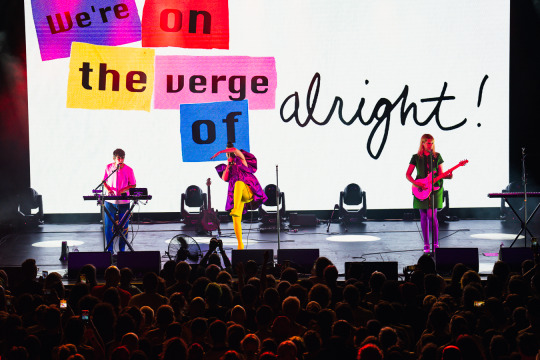

But 20 years on from the band’s last live show, can we have a little fun too? Thankfully, the answer was a resounding yes on Thursday night at Brooklyn Steel, the first of the hometown band’s three sold-out nights in Brooklyn — and their last three on tour after many years away. It’s hard to name an album that I wore out more in my early teens than Le Tigre (1999), so witnessing its songs and lyrics live, bursting with the same hooks, howls and drum loops, was the most special of treats. After rousing and delightfully warm MC’ing by Murray Hill, the band took the stage and launched into the scuzzy guitar loop and dance-y backbeat of “The the Empty,” with Hanna, in puffy purple dress and yellow tights, unleashing her signature battle-cry vocals: “Why won’t you answer me? Answer me! Answer me!”

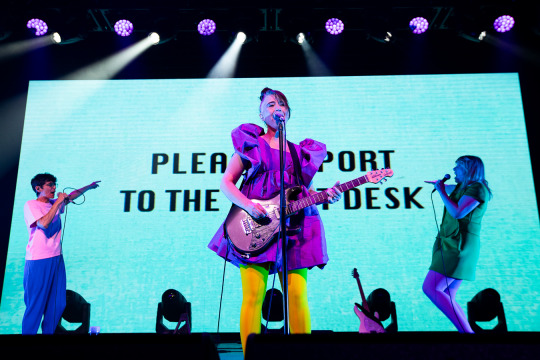
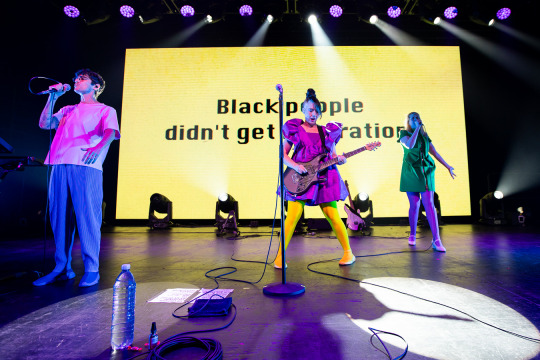

“TKO” (This Island, 2004), with punchy Pop Art backing graphics, followed, then “FYR” (“Fifty years of ridicule”), from Feminist Sweepstakes (2001), whose lyrics flashed behind the trio, the effect landing somewhere between protest poster and APPLAUSE sign: “Can we trade Title IX for an end to hate crime? / RU-486 if we suck your fucking dick.” “What's Yr Take on Cassavetes,” among the most innovative tracks on Le Tigre, brought me back to the band’s lo-fi bedroom-project humor that made me fall in love: You can be this funny and this jaded in music?


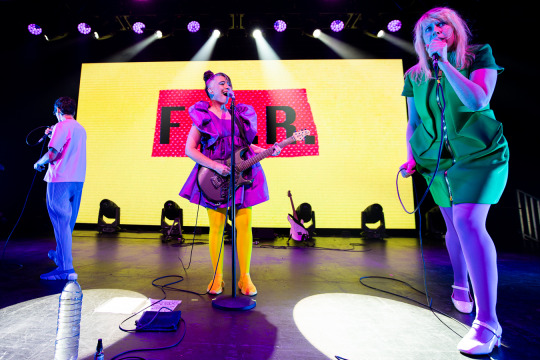

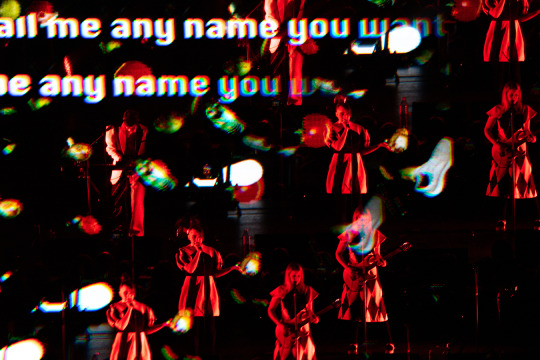
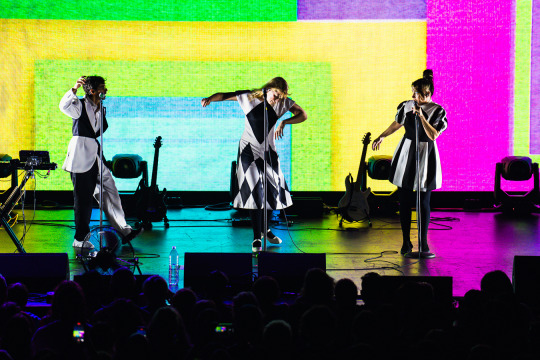
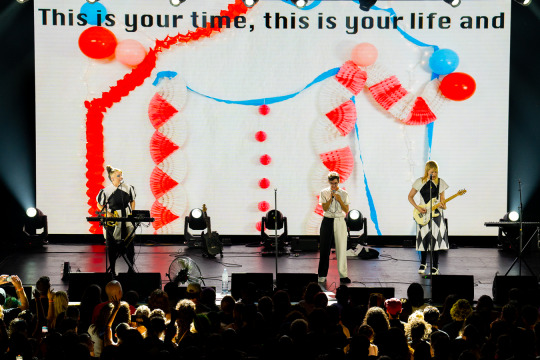
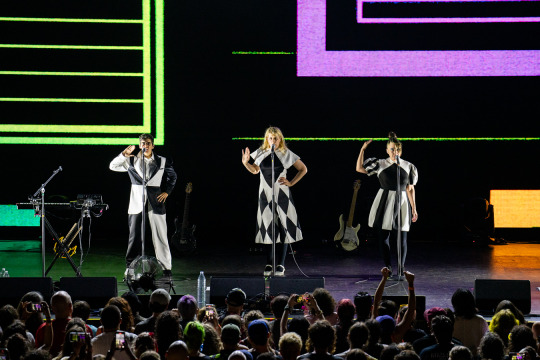
It was nice to know the songs brought them back, too. Fateman took the wheel on “Mediocrity Rules” (From the Desk of Mr. Lady, 2001), a song she said made her feel like she was in her 20s again. Even “Viz” (This Island), which Samson said was about the very real experience of being treated like shit at a party (seemingly not fun to revisit) had the whole room grooving. I struggle, reader, to not detail every moment. “My My Metrocard” in Brooklyn, video art of random garbage-like products, stop-motion scuba divers. “Eau d’Bedroom Dancing” as the set closer. But the real barn burner, of course, was the final song, the encore closer — “Deceptacon,” that singular, perfect bop that somehow opens Le Tigre. “Who took the bomp?” Hanna — and everyone else in the room — screamed. Pure, pure happiness. —Rachel Brody | @RachelCBrody




(Le Tigre play Brooklyn Steel again tonight and tomorrow.)
Photos courtesy of Adela Loconte | www.adelaloconte.com
#Adela Loconte#Bikini Kill#Brooklyn Steel#Feminist Sweepstakes#From the Desk of Mr. Lady#JD Samson#Johanna Fateman#Kathleen Hanna#Le Tigre#Murray Hill#Photos#Rachel Brody#Review#This Island
0 notes